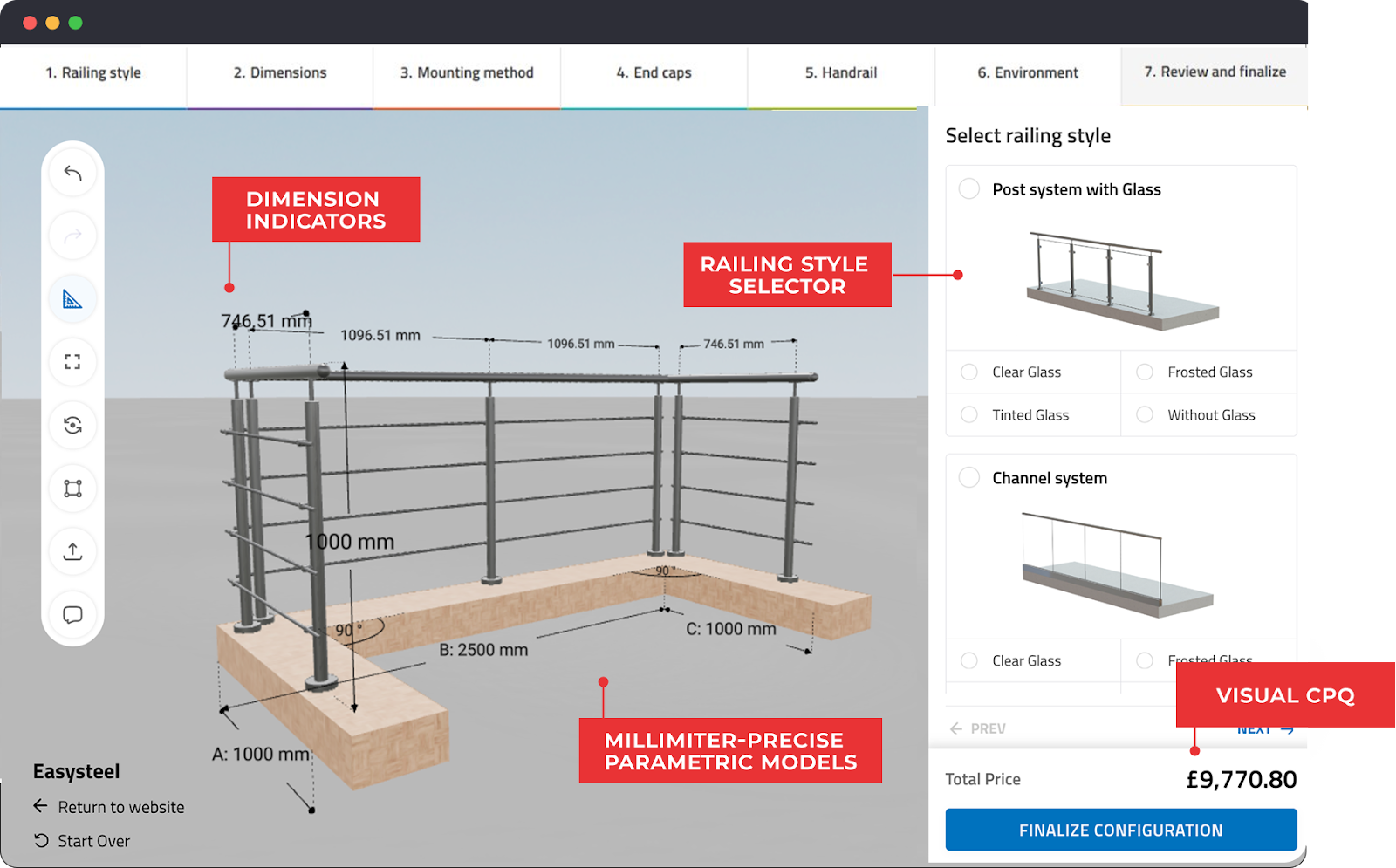Digital Marketing for Building Materials: 5 Hacks for 2026
Digital marketing for building materials now starts long before a buyer speaks to sales. This guide outlines five practical ways to help contractors and homeowners research, compare, and choose your products in 2026.

The building-materials industry isn’t exactly known for being the fastest to adopt digital trends. Many companies still rely heavily on face-to-face sales and long-standing distributor relationships. Those things still matter. But the way buyers research and choose suppliers has shifted, and it’s becoming more obvious every year.
Whether you sell railings, windows, doors, stairs, or any other configurable building product, your customers don’t want to wait for a sales rep to guide them. They begin online. They research and compare long before you know they exist.
That’s why digital marketing for building materials is getting more attention. As we move into 2026, the brands gaining traction aren’t the ones shouting the loudest. They're the ones making it easier for buyers to learn, explore, and make decisions.
Here are five practical hacks to help you do exactly that.
1- Treat Social Media as Real Research Channels
Social media marketing has become a genuine discovery point for building-materials buyers. 75% of B2B buyers use social platforms to support buying decisions, and many silently evaluate suppliers long before filling out a form. In 2026, ignoring social means losing visibility during the earliest stage of research.
Different social media platforms can give you different ways to show what you do. On LinkedIn, you can share project stories, installation clips, or announcements that speak to contractors, architects, or partners. Visual platforms like Instagram or Pinterest are useful for showcasing finished projects, color options, or design ideas. YouTube is a good place for installation guidance, walkthroughs, and longer product explainers.
What consistently works across any social media post is practical, honest content. A short video showing how a module fits together, a quick look at a tricky detail on site, or a simple before-and-after will do more for your credibility than polished but vague product posts. If your social presence helps buyers understand your products faster, it’s doing its job.
2 - Do Not Neglect Your SEO and AEO
In building materials, sales reps, distributors, and referrals still matter. But they rarely create the first interaction anymore. Most buyers start by looking things up online, long before they reach out to a company. Recent data shows that 89% of B2B buyers research online and 60% rely on digital content to make a final decision. Even if the final steps involve site visits or specification work, the early stage is driven by what buyers can learn on their own.
This is where SEO (Search Engine Optimization) and AEO (Answer Engine Optimization) work together. SEO remains essential because it helps buyers find your content during the research phase. But search behaviour is changing. AI generated overviews increasingly answer questions directly on the results page, which means many searches no longer lead to a click. AEO has become just as important for this reason.
AI powered search features continue to take up more space in the results pages. Google AI Overviews appearing in approximately 47% of search results. Additionally, traditional organic traffic is projected to decline by 25% by 2026 as users find answers directly through AI interfaces rather than clicking through to websites.
To stay visible, building materials marketers need content that AI can understand and trust. This means using the same terminology contractors and architects use on site, structuring pages so each section answers one clear question, and real examples. AI tools surface content that is direct, practical, and unambiguous. The more your pages read like a reliable project reference, the more likely they are to appear in AI overviews and zero click results.
3 - Offer an Interactive Customer Experience
Modern B2B buyers prefer to work through most of their evaluation without involving a sales rep. Multiple studies point to the same trend: Gartner reports that 61% of B2B buyers prefer a rep-free buying experience, and FlareAI notes that 70% prefer self-service discovery over traditional sales conversations. This behaviour is also visible in building materials, where buyers try to understand feasibility, compare options, and narrow down choices on their own before they contact anyone.
Interactive tools support this shift. A 3D configurator gives buyers a way to test ideas, explore dimensions, compare materials, and understand limitations without waiting for a response from sales. For marketers, interactive experiences also create a more qualified pipeline. Every configuration captures intent: preferred materials, sizing choices, constraints, and what the buyer is trying to achieve.
When this information reaches your sales team, the first conversation starts at a much higher level because the buyer already understands the basics. It shortens cycles, reduces repetitive questions, and removes a lot of friction.
Giving buyers a way to explore on their own is an essential part of how they expect to research. A configurator turns that expectation into something useful for both sides: a clearer buying process for the customer and better qualified leads for your team. Providing this self guided clarity is one of the fastest ways to improve both digital engagement and lead quality in 2026.

4 - Unlock the Value Hidden in Your Digital Data
Most building materials companies collect far more digital data than they actually use. Website analytics, CRM activity, downloads, all contain signals about what buyers care about, yet many of these signals sit untouched. Supermetrics reports that 56% of marketers do not have the time or the systems to analyze the data they collect. In a category where decisions depend on timing, feasibility, and regional demand, leaving this information unused is a missed opportunity.
For 2026, the real differentiator is not who has data. It is who can interpret it. The shift many leading building material brands are making is from being data-driven to being data-informed. Data-driven teams let metrics dictate every move. Data-informed teams use analytics to frame decisions, then apply professional judgment, market context, and field insight to decide what actually matters.
For marketers, the goal is to look for patterns rather than isolated metrics. Use those insights to decide where to focus campaigns, which target audiences to prioritize, which products need more educational content, and where regional demand is shifting. And with LLMs now able to handle this easily through integrations, connectors, or even simple data uploads, the barrier to turning raw information into usable insight is lower than ever. When data becomes context instead of a dashboard, marketing stops being reactive and starts guiding real growth.
5 - Use Content to Show Expertise and Build Trust
Once buyers find your website, they want to understand whether your company is the right supplier. Educational content marketing plays a central role in this evaluation. Research shows that 74% of B2B buyers read three or more pieces of content before making a decision. This applies strongly in building materials where decisions depend on clarity, not slogans.
Content in building materials is about practical value. Comparison guides, case studies, job site photography, videos, and step-by-step explanations help buyers understand what is possible and what is not. Commercial teams use these resources to validate feasibility. Homeowners use them to understand design implications and installation expectations.
According to recent studies, 95% of B2B buyers are not ready to speak to sales when they first engage with a brand. This makes educational content essential. It gives a way to build trust and nurture potential customers before they make purchasing decisions.
Easysteel: a Building Material Brand with Strong Digital Marketing
Easysteel, a modular railing systems manufacturer, is a strong example of how a building materials brand can use digital channels to make a complex product easier to understand. Their website guides visitors through a simple flow: see real projects, browse components, and then move straight into the 3D configurator. Everything is focused on helping buyers make sense of their options without needing to contact someone first.
The 3D configurator is at the center of that experience. It is simple to use, visually clear, and aligned with real project workflows. Buyers can:
- Sketch their railing layout with accurate dimensions
- Place posts, corners, and segments in a realistic visual environment
- Test different materials and fittings with instant visual updates
- See pricing change as they adjust the design
- Directly add the custom railings to their cart, or ask sales to reach out

This turns what is usually a back and forth process into something visual and simple. Buyers do not need to guess what will work or wait for someone to respond. They can create a layout that aligns with their space, understand how components fit together, and commit to a purchase when they are ready.
The experience helps buyers move from exploration to configuration to purchase without friction, and each part of the journey answers a question they already bring into the process. It is a clear example of how digital marketing can directly support sales in the building materials space by giving buyers the clarity and confidence they need to move forward.

Wrapping Up
Digital marketing strategy in building materials works best when it reflects the way buyers research today. They want clarity, they want to understand options on their own, and they want tools that help them make confident decisions.
The companies gaining ground are the ones removing friction from that process. Strong social content, search friendly information, interactive experiences, better use of data, and practical educational resources. It all supports the way contractors, specifiers, and homeowners move through a project.
If you want to offer your buyers a clearer and more useful digital experience, we can help. Salsita builds 3D configurators for building materials brands, designed to simplify complex products and give buyers the ability to explore, test, and configure their projects with confidence.


